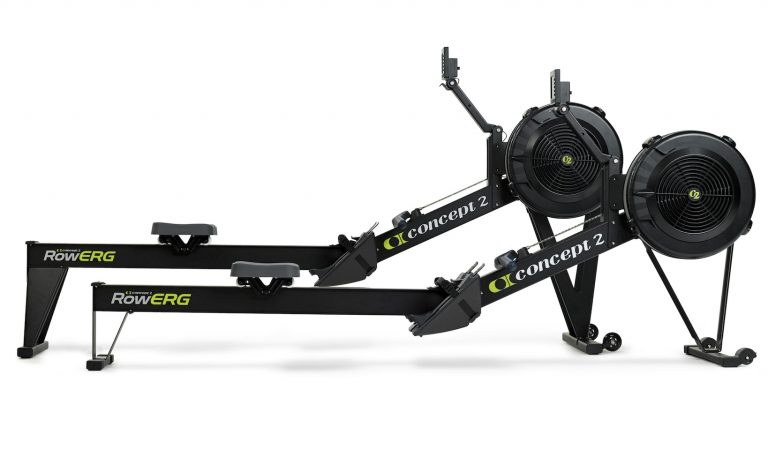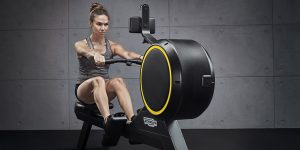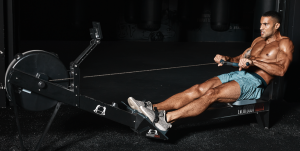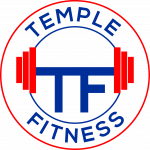Row, Row, Row Your Boat

Indoor rowing is all the rage: rowing machines — also referred to as ergs — are making cameo appearances in commercials for all sorts of products, from fitness trackers to pharmaceuticals. Professional and Olympic athletes are touting rowing’s benefits for cross-training and general fitness.
Meanwhile, rowing classes are popping up in gyms, boutique studios and CrossFit boxes everywhere. Options to do classes from home are growing as well.
The bottom line, indoor rowing is hot! Awesome — but how to jump on that bandwagon?
We hear from people all the time who want to add rowing to their workouts, but they don’t know where to begin. They’re not sure how to row correctly, and they wonder what more they could do with it besides sitting down and pulling on the handle stroke after stroke.
Rowing Is For Every Body
In fact, the rowing machine is one of the most versatile pieces of cardio equipment you can find. A rowing workout can get your heart pounding and muscles burning, calm your mind and body as you relax into the rhythm of the stroke or anything in between. Plus, it’s a low-impact activity that works virtually every muscle on every stroke!
Regardless of your age, fitness level, the intensity of the workout you want, or your fitness goals, the rowing machine can help you get there.
Getting Started with Indoor Rowing Workouts
If you’re just getting started on the rowing machine, give yourself some time to get comfortable with the stroke. The basic elements of the rowing technique are pretty simple: just think legs–body–arms, arms–body–legs. Beyond that, we like to say that rowing is like golf: the relentless pursuit of the perfect stroke.
To get a feel for the technique, you can watch videos or ask one of our coaches to give you a few lessons. Please don’t skip this step. You wouldn’t perform other moves in the gym without learning how to do them first — rowing is no different. Like any other exercise, you’ll get more out of it and get better results if you learn how to do it properly.
Rowing Terms to Know
On-water rowing is a centuries-old sport that has its own terminology, and a lot of it has carried over to the indoor world. Here are some phrases you will come across often.
Split
The “split per 500” or the time it takes you to row 500 meters. This will be displayed in a central location on your monitor. Your goal is to make the number smaller, which means you’re getting faster!
Strokes Per Minute (SPM), a.k.a. Stroke Rating (Rating)
The number of strokes you take in a minute. Remember, a high stroke rating does not necessarily equate to a faster split or overall time. The key is to generate as much power as you can on the drive when you push off the foot stretchers, no matter how many strokes you take in a minute.
Damper Setting
The placement of the damper on the side of the fan on rowing machines with flywheels. We recommend a setting of 3-5, which is also where most competitive rowers have it. Setting the damper at 8-10 opens the flywheel for maximal airflow and, thus, resistance as you row. Very much like riding a bike on a hard gear, rowing will feel heavy at 10 and thus be hard to sustain over a long workout.
Paddle or Rest
In rowing, you never completely stop until the workout or the race is over. When you see “rest” in a workout here, that means you row easily, taking the pressure off for the time or distance specified.
Equal Rest
Rest the same time or distance as the work interval.
Piece
A “piece” of a workout. For example, in a workout that is 4 x 500 meters, each 500-meter effort is a piece.
Steady-State Rowing
Often found in longer workouts, this is rowing at about 60 to 70 percent of your max, where you can talk, but it’s an effort. A pace that you feel you can hold for quite a while.
Power Strokes
Strokes done at a higher intensity, usually for a relatively short time, like 10 or 20 strokes.

How to Add Rowing to Your Workout
Despite its past as the lonely piece of equipment languishing in a corner of the gym floor, the rowing machine is one of the most versatile pieces of cardio equipment there is.
You can row:
- At the beginning or end of your workout
- As part of an interval workout where you use other equipment as well
- For your entire workout
If you just want to dip your toe into indoor rowing, jump on the machine for your warm-up or cool-down. Since rowing is a total-body movement, it’s a great way to get ready for the sweat to come.
A great way to do a rowing warm-up is to use what’s called the “pick drill,” which picks apart the rowing stroke and allows you to practice its various elements, here demonstrated by my colleague and business partner Terry Smythe.
Try this rowing workout warm-up:
- Work your way through the pick drill and slowly progress until you’re rowing at a full slide.
- Row at a steady pace for 6 to 15 minutes at 18 to 24 strokes per minute, gradually easing into a sustained effort with a few bursts of 10 power strokes at 26 to 28 strokes per minute every two or three minutes.
Remember: Nobody wins the warm-up. Don’t look at it as a race or competition; do what feels good to you to get your body ready for your workout.
Bringing the Row Into the Workout
Once you’re confident with your rowing, it’s time to bring it onto the main stage — your workout.
One easy way to add rowing to any routine is to include a short rowing interval in whatever circuit you have planned for the day. Anywhere from one to five minutes or 250 to 1000 meters of rowing at the beginning of a round will get your heart rate up and add a nice cardio boost.

Rowing for Intervals
Want to get more structured with your interval rowing workout? Here are some of my favourites:
The 500s
Perform four to six rounds of the following circuit:
- Row 500 meters at 24 to 28 SPM.
- Perform 10 push-ups, sit-ups, squats or squat jumps after each 500-meter interval.
After the last 500-meter interval, just take all the intensity off and paddle (row easy) for three to five minutes until your heart rate comes down, and you are comfortable to get off and stretch.
Try to hold your split (pace) steady for each 500-meter interval, or to make it harder, try to beat your previous 500-meter time every round.
3-2-1 Row!
Row intervals of three, two, and one minute. In between each interval, perform:
- 12 goblet squats
- 12 dumbbell push presses (or thrusters)
- 12 bodyweight sumo squats with a twist with arms extended
- 12 sit-ups (or mountain climbers)
Rowing for Meters
If you want to keep it simple and still get a great workout that’s not boring, try one of these rowing-only workouts:
Meter Pyramid
Row the following intervals, adding the same amount of paddle rest as you did work in between each interval:
- One minute
- Two minutes
- Three minutes
- Four minutes
- Three minutes
- Two minutes
- One minute
So the first round would be a minute of rowing, a minute of rest, the second round is two minutes of rowing, two minutes of rest, and so on. Stay on the rower until you have completed the workout. If you need a drink, grab it during the rest intervals, not during the work.
Some rowing machines even have this workout in their pre-programmed routines so you can easily repeat it at a later date and test your progress.
Stroke Play
This is a great workout for when you’re learning to increase your effort level on the rowing machine.
Warm up, then set your monitor for 10 to 30 minutes. Row one minute with effort, at 24 to 28 strokes per minute, followed by one minute at an easy pace with no intensity, around 22 strokes per minute. Be sure to use the recovery to ease up, breathe and get water as needed.
Allow yourself to build your effort during the last 10 seconds of the rest interval so that you’re working for the entire minute of effort. That’s what we call this stroke play.
Play with different strokes per minute on the work interval to see where you feel best and are most productive. Remember that the rest interval is always about recovery and prep for the next round of work.

Row Down for Your Cool-Down
Just as it’s a good warm-up, the pick drill is always a good finish to a rowing workout as well. The best time to work on technique is when you’re tired, and the pick drill will both help you reinforce the muscle memory needed for correct technique and allow you to bring your heart rate down.
Rowing easy for three to 10 minutes is a great way to ease out of a workout. Try closing your eyes while rowing or taking your feet out of the foot straps to feel the fluidity of the stroke and correct any flaws you may have.
However you decide to row, have fun with it!
